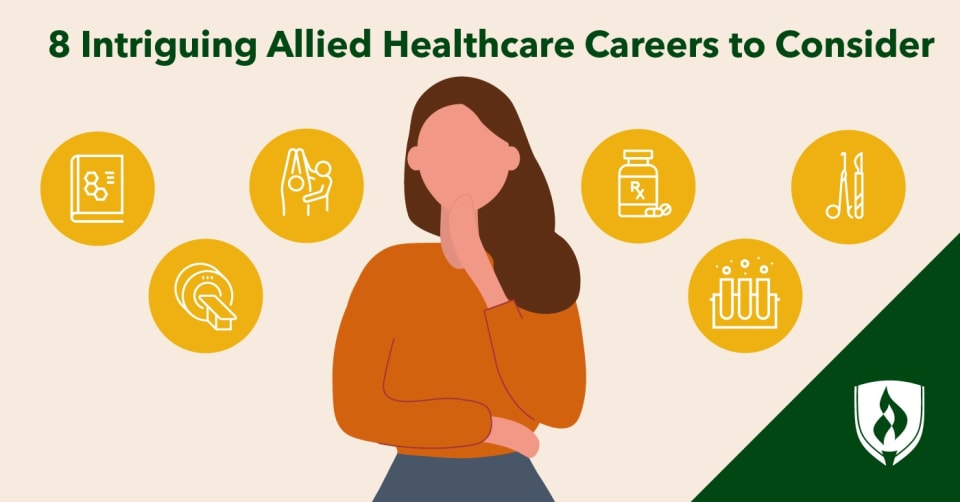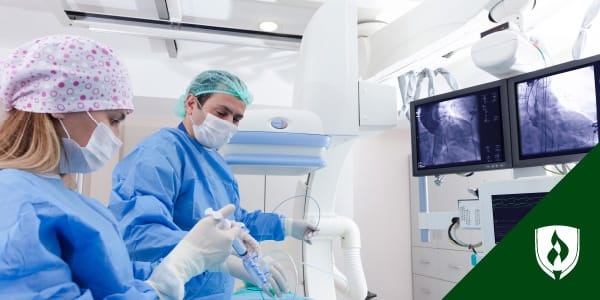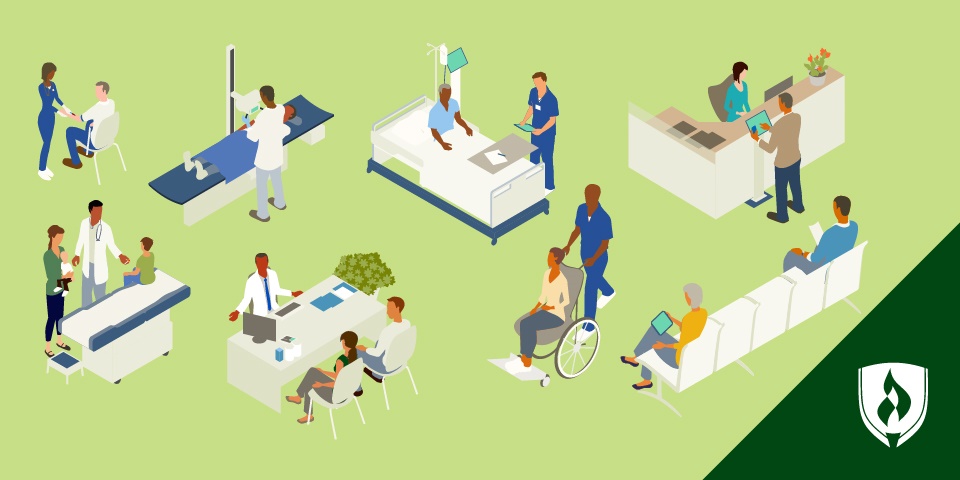
As you’ve considered your potential career options, you can’t help but fixate on the healthcare field. The idea of earning a living by helping people address their health issues is certainly appealing. While it’s easy to immediately think of doctors or nurses when putting together a list of healthcare career options, you also know there’s a lot more out there worth your consideration.
A large portion—one estimate from 2009 says 60 percent—of healthcare jobs overall are considered allied health positions.1 With that in mind, it’s easy to understand why allied health roles should be firmly on your radar as there are far too many potential opportunities under this umbrella to ignore. While there’s some nuance in the definition, the Association of Schools Advancing Health Professions (ASAHP) states the term allied health covers “health professions that are distinct from medicine and nursing.”2
You’ll find a wealth of potential job options under this category: physical therapists, dental hygienists, health information professionals, medical assistants, radiologic technologists, phlebotomists, pharmacy technicians and more. Many of these careers feature a compelling and accessible pathway into the healthcare field. In this article, we’ll walk through the allied health careers that Rasmussen University programs can help prepare you for.
8 Allied healthcare careers you should have on your radar
Looking to expand your list of potential healthcare career paths beyond becoming a doctor or a nurse? Give these options a second look.
1. Medical laboratory technician
What they do: If you’ve ever had to get tested for strep throat and had your provider explain that they’d have to wait for results from “the lab,” these are some of the people working in that lab. Medical laboratory technicians work to analyze blood, urine or tissue samples to help providers diagnose and treat patients. They are skilled at operating sophisticated laboratory equipment. You’ll find lab technicians working in labs in hospitals, dedicated medical and diagnostic labs, colleges, and physicians’ offices.
Keep in mind that there is a difference between technicians and technologists in the labs. Technologists perform more complex tests then technicians do. The tests technicians perform are often more routine and automated—but still require skill and training to ensure they are done properly.
Job outlook: Employment of medical laboratory technologist and technicians is projected to grow seven percent between 2019 and 2029 according to the BLS, faster than the national average for all occupations (four percent).3
Education required: Medical laboratory technicians must hold a Bachelor’s degree in laboratory science; however, technicians may be qualified with a Medical Lab Technician Associate's degree or other laboratory science-focused programs. Additionally, some states may require licensure in order to practice.4
2. Surgical technologist
What they do: These are the healthcare professionals who set the stage for successful surgical procedures. It is typically the responsibility of the surgical tech to prepare both the patient and the operating room (OR) for surgeries. This includes sterilizing the equipment and ensuring there are adequate supplies in the OR before the surgery begins. They also help prep the patients by cleansing and disinfecting any incision areas.
During the surgery, the surgical tech may assist the surgeon by handing them instruments at their request. Additionally, they may help with patient positioning or using retractors during the procedure. Once the surgery is complete, a surgical tech will help dress the wound and transfer the patient into a recovery room and then assist with restocking and sterile clean-up.
Job outlook: The BLS projects employment of surgical technologists to grow at the faster-than-average rate of seven percent from 2019 through 2029.3 The need for surgeries is growing as the large baby boomer generation gets older and surgical technologies advance.
Education required: Most employers require a postsecondary (after high school) certificate or a Surgical Technologist Associate's degree to work in this position, according to the BLS.3,5
3. Health information technicians
What they do: If the up-close-and-personal nature of a surgical technologist’s job description has you second-guessing yourself, a health information role may be a better fit. While the specifics will depend on the exact role, these healthcare professionals assist with the documentation and transmission of important medical information for billing and record-sharing purposes. This can include the translation of medical documentation into standardized medical codes, which are used to provide accurate billing and medical records systems. These professionals work behind the scenes in a variety of settings, including hospitals, urgent care facilities, nursing homes and insurance providers, ensuring all pertinent information is coded appropriately to ensure consistency and accuracy.
Job outlook: Employment of medical records and health information technicians is projected by the BLS to grow eight percent from 2019 to 2029, much faster than the average for all occupations.3
Education required: The BLS reports that some health information roles may be attainable with a high school diploma, many prefer candidates who’ve completed a postsecondary certificate program, like the Medical Billing and Coding Certificate program at Rasmussen University.3 Additionally, more advanced roles within the health information field may prefer candidates with a Health Information Technician Associate’s degree or a Health Information Management Bachelor’s degree.6
4. Medical assistants
What they do: If you’re looking for a role that offers a mix of administrative duties and direct patient care, a medical assistant position may be a good choice. On the patient-care side, medical assistants record vital signs, compile medical histories and, in some states, can administer medications or vaccinations. They also play a big role in scheduling appointments or procedures and assigning with billing and insurance matters on the administrative side. These duties can vary depending on the setting—hospital or outpatient clinic.
Job outlook: Job prospects for medical assistants appear to be strong. The BLS projects employment of medical assistants to grow 19 percent from 2019 to 2029.3
Education required: While most states have no formal education requirements for these roles, most medical assistants have completed some form of postsecondary education or training. This training is relatively short when compared to some healthcare careers—the Medical Assisting Diploma program at Rasmussen University can be completed in as few as 12 months and provides an excellent foundation of healthcare skills.7
5. Pharmacy technicians
What they do: When you stop by the pharmacy to pick up a prescription, these are the healthcare professionals working behind the counter to meet customer needs. Pharmacy technicians (or pharmacy techs, for short) work under the supervision of a licensed pharmacist to help dispense medications for customers or health professionals, according to the Bureau of Labor Statistics (BLS).3 This role also involves a fair amount of administrative work and customer service skills as they assist customers with navigating insurance and billing questions.
Job outlook: Employment of pharmacy technicians is projected to grow four percent from 2019 to 2029, according to the BLS.3
Education required: Some pharmacy technician jobs can be secured with just a high school diploma and on-the-job training. However, the BLS specifies that most states regulate pharmacy technicians, which may require passing an exam or complete a formal education program, like the Rasmussen University Pharmacy Technician Certificate program.3,8
6. Community health worker
What they do: These public-facing health professionals work to improve health outcomes in a given population or community. Community health workers serve as a liaison between the community and healthcare, government and social service systems. They provide advocacy education and support to community members to help them improve their lifestyles and receive healthcare.
Job outlook: The BLS projects employment of community health workers to increase 15 percent through 2029.3 This optimistic outlook is partly due to the desire for government, healthcare and social services providers to find ways to improve health outcomes through lower-cost preventative measures.3
Education required: Though it is possible to find community health worker jobs without a Bachelor’s degree, acquiring one can help increase your job prospects or allow you to take on a more specialized role. Common fields to earn a degree in include Health and Wellness and Public Health.9
7. Radiologic technologist
What they do: These diagnostic imaging specialists help provide healthcare professionals with a clear picture of what’s going on below the skin of a patient. These professionals use several types of equipment to gather images that help physicians diagnose patient ailments and determine the best course of action for treatment.
Radiologic technologists are experts in X-ray imaging and often expand their expertise into computed tomography (CT) imaging, magnetic resonance imaging (MRI) or positron emission tomography (PET).
Job outlook: The BLS reports that employment of radiologic technologists is projected to increase seven percent through 2029, faster than the average for all occupations.3
Education required: Most radiologic technologists earn an Associate’s degree before entering the field.10
8. Physical therapist assistant
What they do: Want to help people get back on their feet and moving to the best of their ability? This could be the role for you. Physical therapist assistants (PTAs) work with physical therapists to rehabilitate patients who are working to regain their full range of motion and strengthen injured muscle groups. They observe their patients’ progresses and assist them as they work through the rehabilitation routines and exercises needed get them back on track. The professionals work with a wide variety of patients, from athletes recovering from injury to elderly patients working to maintain or regain mobility as their joints and strength deteriorate.
Job outlook: PTAs are among the top 10 fastest-growing occupations in the next decade, according to the U.S. Bureau of Labor Statistics (BLS).4 Physical therapist assistant employment is projected to increase 33 percent through 2029.4
Education required: Physical therapist assistants must have an Associate’s degree from an accredited program that includes courses, labs and clinical training. After graduation, PTAs must pass the National Physical Therapy Exam for physical therapist assistants to become licensed in their states.11
Choose your allied healthcare career path
As you can see, there are a multitude of options in healthcare that fall into the allied health realm—so many we can’t list them all here. All the ones listed here require an Associate’s degree or less, though the world of allied offers plenty of room of advancement with additional education.
While all these difference choices may make your career search overwhelming, the variety means you’re bound to find a position you would enjoy. Visit the Rasmussen University School of Health Sciences page to see all you could accomplish here.
Related Articles:
1National Academy of Sciences, “Ensuring Quality Cancer Care through the Oncology Workforce: Sustaining Care in the 21st Century: Workshop Summary” 2009 [accessed April 2021] https://www.ncbi.nlm.nih.gov/books/NBK215247/
2Association of Schools Advancing Health Professions, “What Is Allied Health?” [accessed April 2021] https://www.asahp.org/what-is
3Bureau of Labor Statistics, U.S. Department of Labor, Occupational Outlook Handbook, [information accessed April 2021]. www.bls.gov/ooh. Employment conditions in your area may vary.
4Graduation from a campus with programmatic accreditation is required to meet the educational requirements to sit for the American Society for Clinical Pathology (ASCP) Board of Certification exam. The ASCP credential may be required for state professional licensure or certification. Other eligibility requirements may apply to state and national licenses and certifications: please verify your eligibility against applicable rules, which may change at any time.
5The Surgical Technologist Associate's Degree is a residential program designed to lead to careers in Florida, Illinois, Minnesota, and Wisconsin. While this program is only offered at select campuses in those states, determinations regarding professional licensure or certification have been made for other states. Graduation from a campus with programmatic accreditation is a requirement to sit for the Certified Surgical Technologist ("CST") certification through the National Board of Surgical Technology and Surgical Assisting (NBSTSA). The CST certification may be required for state professional licensure or certification. Other eligibility requirements may apply to state and national licenses and certifications; please verify your eligibility against applicable rules, which may change at any time.
6The Health Information Management accreditor of Rasmussen University is the Commission on Accreditation for Health Informatics and Information Management Education (CAHIIM). The following Health Information Technician programs at Rasmussen University are accredited by the Commission on Accreditation for Health Informatics and Information Management Education (CAHIIM) based on their associate-level Health Information Management standards and are reaffirmed through the following dates: Rasmussen University– Bloomington, Eagan, Lake Elmo/Woodbury, Mankato and St. Cloud, Minnesota, through 2022; Rasmussen University – National Online through 2025. All inquiries about the program’s accreditation status should be directed by mail to CAHIIM, 200 East Randolph Street, Suite 5100, Chicago, IL, 60601; by phone at 312-235-3255; or by email at [email protected].
Graduates of the CAHIIM-accredited Health Information Technician Associate's Degree programs, listed in the CAHIIM accreditation statement above, meet the educational requirements to sit for the American Health Information Management Association (AHIMA) Registered Health Information Technician (RHIT) certification exam. This program is not designed to prepare graduates for any other professional licenses or certifications.
7Completion time is dependent on transfer credits accepted and courses completed each term.
8The Pharmacy Technician Certificate and the Healthcare/Health Sciences Associate's Degree - Pharmacy Technician Specialization meet or exceed the educational requirements for professional licensure or certification in the states as displayed in the Rasmussen University catalog. Not all states require licensure or certification for this profession. Each state determines its own requirements for licensure or certification as a pharmacy technician. In many states, the minimum educational requirement is a high school diploma or equivalent, but employers may value educational attainment beyond the high school level. Other eligibility requirements may apply, including experience working in a pharmacy and passing a board-approved licensure examination. Please check with the board of pharmacy or equivalent agency in your state for further details as requirements may change at any time.
9The Health and Wellness Bachelor's Degree and Master of Public Health programs are not designed to prepare graduates for any state-issued professional license or certification, and have not been approved by any state professional licensing agency. For further information on professional licensing requirements, please contact the appropriate board or agency in your state of residence.
10The Radiologic Technology Associate's Degree is a residential program designed to lead to careers in Florida and Minnesota. While this program is only offered at select campuses in those states, determinations regarding professional licensure or certification have been made for other states as displayed in the Rasmussen University catalog. This program meets the education requirements to apply for certification through the American Registry of Radiologic Technologists (ARRT). ARRT certification may be required for state professional licensure or certification. Other eligibility requirements may apply to state and national licenses and certifications; please verify your eligibility against applicable rules, which may change at any time.
11The Physical Therapy Assistant Associate's Degree is a residential program designed to lead to careers in Florida and Minnesota. While this program is only offered at select campuses in those states, determinations regarding professional licensure or certification have been made for other states as displayed in the Rasmussen University catalog. This program meets the education eligibility requirements to register for the National Physical Therapy Exam (NPTE) for Physical Therapy Assistants through the Federation of State Boards of Physical Therapy (FSBPT). Passing the licensure exam is required for state licensure in all jurisdictions. Other eligibility requirements may apply to state and national licenses and certifications; please verify your eligibility against applicable rules, which may change at any time.

-(1).png)


